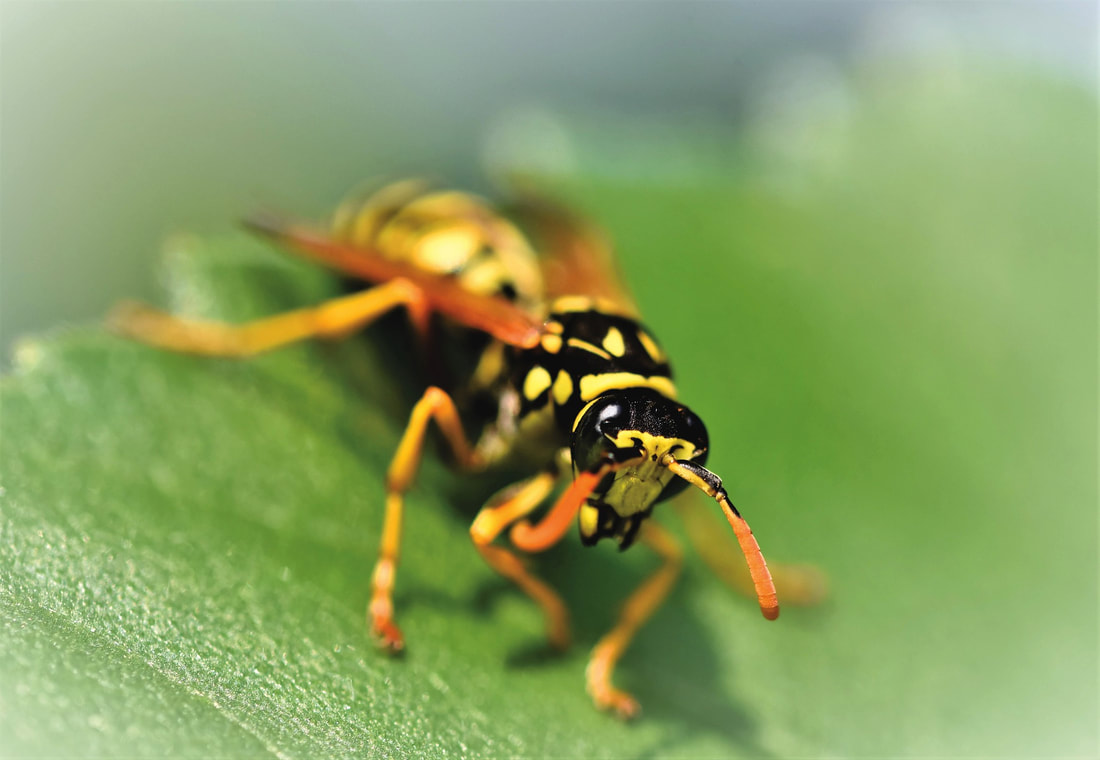
Urban and suburban landscapes host a variety of wasp species-each with distinct behaviours, colony structures, and risk profiles. Proper identification is critical not just for public safety, but also for determining the most effective pest control strategy.
🐝 Yellowjackets (Vespula spp.)
Yellowjackets are highly aggressive with distinct black-and-yellow markings. Their nests, typically enclosed and made of paper-like material, are commonly found:
-
Inside wall voids
-
Under soffits
-
In abandoned rodent burrows
-
Within attic insulation
These wasps pose a significant stinging hazard, especially from late July to September, when colony sizes peak and food sources dwindle. They’re drawn to protein and sugar sources like meat, ripe fruit, soda cans, and garbage bins. Yellowjackets are a top contributor to anaphylactic reactions in Ontario.
Behavioural traits:
-
Territorial and will sting when the nest is disturbed
-
Capable of stinging multiple times
-
Often build nests in hidden entry points that are difficult to spot without a thorough inspection
🕯️ Paper Wasps (Polistes spp.)
These types of wasps are slender-bodied and have dangling legs in flight. They construct open-cell nests, often shaped like an inverted umbrella, under horizontal surfaces:
-
Porch ceilings
-
Eaves and overhangs
-
Window frames
-
Play structures and patio furniture
Though less aggressive than yellowjackets, they will defend their nests if approached. Paper wasps are frequently involved in accidental stings, particularly when people unknowingly disturb nests during home maintenance or gardening.
Identification tips:
-
Dark brown or reddish color with yellow markings
-
Nests have visible hexagonal cells
-
Colonies are smaller-usually fewer than 100 individuals
⚫ Bald-Faced Hornets (Dolichovespula maculata)
Despite the name, bald-faced hornets are technically aerial yellowjackets. Easily identified by their black bodies with white facial markings, they build large aerial nests-often the size of a football or larger-in trees, on utility poles, and sometimes under second-story eaves in Toronto’s older neighbourhoods like Roncesvalles or The Annex.
High-risk traits:
-
Extremely protective of their nest
-
Known for chasing intruders away from the area
-
Colonies may contain up to 700 workers at peak
These hornets are frequently the subject of emergency removal calls due to their visibility and aggressive defence response.
🟤 Mud Daubers and Solitary Wasps
Unlike social wasps, mud daubers do not pose a major sting threat. They are solitary insects that construct small, cylindrical nests from mud-often on exterior walls, garages, or around window sills.
Mud daubers are beneficial to the ecosystem, feeding on spiders and other insects. Their presence typically doesn’t require professional intervention unless nests accumulate near entry points or in commercial facilities where client perception is a concern.
🛠️ Carpenter Bees: A Common Misidentification
Often confused with wasps due to their similar size and hovering flight, carpenter bees are more closely related to bumblebees. Unlike wasps, they are pollinators and rarely sting. However, they can damage wooden structures by boring holes into soffits, decks, and siding.
In Toronto, especially in older wooden-frame homes in areas like Cabbagetown or High Park, misidentified carpenter bee activity often leads to unnecessary insecticide use.
DIY Wasp Control Tips (With Caution)
Toronto homeowners and tenants often explore do-it-yourself wasp control options during peak activity months-typically May through September. While some localized efforts can reduce wasp presence around homes, improper techniques or misidentification can escalate the situation and pose serious health risks. This section outlines practical DIY strategies, when to apply them, and when to leave the job to trained pest control professionals.
🧰 Basic DIY Actions to Reduce Wasp Activity
For minor, non-aggressive activity or early nest detection, the following methods can reduce risk or delay nest development:
1. Entry Point Sealing
-
Where: Caulking gaps in soffits, fascia boards, foundation wall penetrations, dryer vents, and attic rooflines
-
When: Late fall or early spring (before nest activity begins)
-
What to Use: Expanding foam, weather-resistant caulk, fine mesh over vents
Tip: Wasps exhibit thigmotactic behavior-preferring narrow, enclosed areas to build nests. Sealing these crevices early reduces harborage sites.
2. Nest Decoys
-
Hanging decoy nests (paper lantern-style)
-
Most effective against territorial species like paper wasps
-
Best deployed before mid-May to prevent colony establishment
3. Wasp Traps (Protein & Sugar Baits)
-
Can capture foraging workers and queens
-
Homemade options: sugar water + vinegar + dish soap
-
Commercial traps with attractants should be placed at perimeter fences, not near patios or entry doors
-
Caution: May increase activity if not placed strategically
4. Physical Nest Removal (ONLY for Small, Inactive Nests)
-
Apply at night, when colony is dormant
-
Use aerosol wasp spray from 3–4 metres away
-
Full PPE recommended: long sleeves, goggles, gloves
-
Remove the nest 48 hours later if no activity persists
Warning: Attempting to remove active nests, particularly those of yellowjackets or bald-faced hornets, is dangerous and can result in multiple stings.
🚫 Common DIY Mistakes That Lead to Escalation
| Mistake | Consequence |
|---|---|
| Spraying the nest during the day | Triggers aggressive defensive swarm |
| Plugging a nest hole before treating | Forces wasps to burrow deeper or create new exit paths indoors |
| Treating without proper ID | Risk of attacking beneficial bees or non-aggressive solitary wasps |
| Using dish soap or boiling water | Ineffective and increases aggression |
| Attempting ladder-based nest removal | High risk of falls and stings |
🧪 Insecticides and Safety Considerations
While several over-the-counter insecticides are available at Canadian hardware stores, improper use may violate Health Canada’s PCP (Pest Control Products) regulations or WHMIS compliance rules.
If using a store-bought spray:
-
Look for a PCP registration number
-
Follow all label instructions and Restricted Entry Intervals (REI)
-
Keep children and pets away during and after treatment
🕒 When to Call a Licensed Exterminator
DIY has its limits. Professional intervention is recommended when:
-
The nest is larger than a tennis ball
-
It’s located above 3 metres, in a wall void, or inside a roofline
-
The wasps are exhibiting aggressive or territorial behaviour
-
Allergic individuals or pets live nearby
-
The infestation recurs after multiple DIY attempts
Licensed pest control technicians utilize residual insecticides, dusting tools, and foam applicators to address nests effectively, with reduced risk and no re-entry until it’s safe.
Author Bio: Naeem Choudhry
Pest Control Expert
Naeem Choudhry is a seasoned pest control specialist with over 20 years of hands-on experience. Based in Toronto, he stays up to date with the latest industry best practices and is an active member of the National Pest Management Association of Canada.
Known for his practical tips and outstanding customer service, Naeem frequently hosts community workshops where he educates the public on pest identification, behaviour, and effective control methods. When he’s not out in the field, he shares his expertise through articles, educational events, and community outreach initiatives.
For more insights, follow him on x.com.
